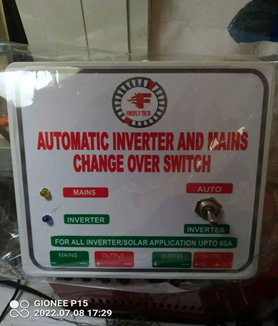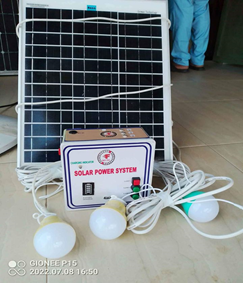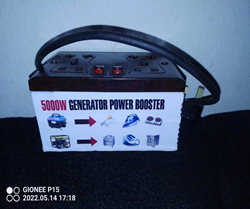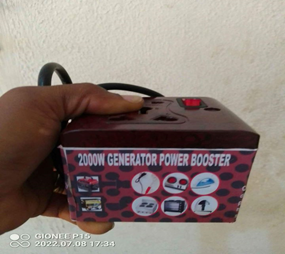GEOELECTRIC IMAGING IN GROUNDWATER EVALUATION
USER'S INSTRUCTIONS: The project work you are about to view is on "geoelectric imaging in groundwater evaluation". Please, sit back and study the below research material carefully. This project topic (geoelectric imaging in groundwater evaluation) have complete 5(five) Chapters. The complete Project Material/writeup include: Abstract + Introduction + etc + Literature Review + methodology + etc + Conclusion + Recommendation + References/Bibliography.Our aim of providing this "geoelectric imaging in groundwater evaluation" project research material is to reduce the stress of moving from one school library to another all in the name of searching for "geoelectric imaging in groundwater evaluation" research materials. We are not encouraging any form of plagiarism. This service is legal because, all institutions permit their students to read previous projects, books, articles or papers while developing their own works.
TITLE PAGE
BY
---
--/H2013/01430
DEPARTMENT OF ----
SCHOOL OF ---
INSTITUTE OF ---
DECEMBER,2018
APPROVAL PAGE
This is to certify that the research work, "geoelectric imaging in groundwater evaluation" by ---, Reg. No. --/H2007/01430 submitted in partial fulfillment of the requirement award of a Higher National Diploma on --- has been approved.
By
--- . ---
Supervisor Head of Department.
Signature………………. Signature……………….
……………………………….
---
External Invigilator
DEDICATION
This project is dedicated to Almighty God for his protection, kindness, strength over my life throughout the period and also to my --- for his financial support and moral care towards me.Also to my mentor --- for her academic advice she often gives to me. May Almighty God shield them from the peril of this world and bless their entire endeavour Amen.
ACKNOWLEDGEMENT
The successful completion of this project work could not have been a reality without the encouragement of my --- and other people. My immensely appreciation goes to my humble and able supervisor mr. --- for his kindness in supervising this project.
My warmest gratitude goes to my parents for their moral, spiritual and financial support throughout my study in this institution.
My appreciation goes to some of my lecturers among whom are Mr. ---, and Dr. ---. I also recognize the support of some of the staff of --- among whom are: The General Manager, Deputy General manager, the internal Auditor Mr. --- and the ---. Finally, my appreciation goes to my elder sister ---, my lovely friends mercy ---, ---, --- and many others who were quite helpful.
PROJECT DESCRIPTION: This work "geoelectric imaging in groundwater evaluation" research material is a complete and well researched project material strictly for academic purposes, which has been approved by different Lecturers from different higher institutions. We made Preliminary pages, Abstract and Chapter one of "geoelectric imaging in groundwater evaluation" visible for everyone, then the complete material on "geoelectric imaging in groundwater evaluation" is to be ordered for. Happy viewing!!!
Groundwater utilization as a source of fresh water supply for various purposes in discharge area shows an ever to increasing trend, while land use of recharges also changes as development progresses. To meet its needs, many people rely on land-based exploration and exploitation. Groundwater is one of nature's most valuable and inseparable resources for life on earth. Groundwater exploration requires appropriate and efficient techniques. One commonly used method is geoelectrical imaging. it is efficient and economical to determine groundwater. Geoelectric imaging is one of the variables which is the physical properties of the rock layers below the surface. Rock resistivity data can be used to develop a model of subsurface and stratigraphic structures in terms of electrical properties. Geoelectric resistivity depends on lithology, air content, porosity, and pore ions concentration. This work is on the use of geoeletric imaging in groundwater evaluation.
TABLE OF CONTENTS
COVER PAGE
TITLE PAGE
APPROVAL PAGE
DEDICATION
ACKNOWLEDGEMENT
ABSTRACT
CHAPTER ONE
1.0 INTRODUCTION
1.1 BACKGROUND OF THE STUDY
- DEFINITION AND CAUSES OF GROUNDWATER POLLUTION
- PROBLEM STATEMENT
- AIM AND OBJECTIVE OF THE PROJECT
- SIGNIFICANCE OF STUDY
- SCOPE OF STUDY
- LIMITATIONS TO STUDY
- PROCEDURES INVOLVED IN THE STUDY
- BASIC TERMS IN GROUNDWATER STUDY
- THE STUDY SITE
CHAPTER TWO
LITERATURE REVIEW
- GEOELECTRIC IMAGING
- GROUNDWATER
- GROUNDWATER EVALUATION
- RELEVANCE OF GEOELECTRIC IMAGING IN GROUNDWATER EVALUATION
- FACTORS THAT FACILITATE OR IMPEDE GROUNDWATER EVALUATION VIA GEOELECTRIC IMAGING
CHAPTER THREE
3.0 MATERIALS AND METHOD
CHAPTER FOUR
4.0 RESULTS AND DISCUSION
- RESULT
- DISCUSSION
CHAPTER FIVE
- CONCLUSION
- RECOMMENDATION
REFERENCES
CHAPTER ONE
DEFINITION OF TERMS
GEOELECTRIC IMAGING is a method of using an electrical resistivity instrument that is connected to electrodes, using separate electrodes for current transmission and potential measurement. The electrodes are inserted to a few decimetres into the ground, in a straight line with equal spacing between the electrodes. The electrical resistivity instrument sends out a current into the ground via the current electrodes, while the voltage between the potential electrodes is measured simultaneously. The potential measured depends on the resistivity distribution of the subsurface material. A geometrical factor must be used to calculate the resistivity [Ωm] of the ground from the measured resistance [Ω], which is specific for the chosen electrode geometry. The measured resistivity depends on the combined effect of the investigated earth volume, which would only be equal to the true resistivity in a homogeneous material; hence the measured quantity is referred to as apparent resistivity. In order to estimate the true resistivity distribution of the ground it is necessary to generate a model of the ground which is adjusted so that the model fits a set of measured data, which is nowadays generally done using inverse numerical modelling (inversion) (Robinson, 2018). The resistivity ranges over a large span, from 10-8 to 1016 Ωm, the lowest value are for massive sulphides and the highest are for unweathered igneous and metamorphic rocks.
GROUNDWATER is commonly understood to mean water occupying all the voids within a geologic stratum. Groundwater is water that fills water saturated pathways, including springs that surface naturally. Groundwater is a vital source of water, especially in areas with no drains, streams and rain, and provides an indication of groundwater to the potential for community formation to the extent permitted by their validity in terms of quality and quantity.
Groundwater is one of the nation’s most valuable natural resources; it is the source of about 40 percent of the water used for all purposes exclusive of hydropower generation and electric power plant cooling. Surprisingly for a resource that is so widely used and so important to health and to the economy of the country, the occurrence of ground water is not only poorly understood but is also, in fact , the subject of many widespread misconceptions. Common misconception includes the belief that ground water occurs in underground rivers resembling surface streams whose presence can be detected by certain individuals. These misconceptions and others have hampered the development and conservations of ground water and have adversely affected the protection of its quality.Groundwater occurs everywhere but sometimes its availability in economic quantity depends solely on the distribution of the subsurface geomaterials that are referred to as the aquifers. This implies that where groundwater is not potentially endowed enough, there may be either complete lack or inadequacy due to increasing industrial and domestic needs (Attia, 2007).
Groundwater evaluation: this is a method that is employed for detecting and mapping ground-water contamination under a variety of conditions. The method is based on the fact that formation resistivity depends on the conductivity of the pore fluid as well as the properties of the porous medium. Under favorable conditions, contrasts in resistivity may be attributed to mineralized groundwater with a higher than normal specific conductance originating at a contamination source. Success with surface resistivity methods depends to a large extent on a good knowledge of subsurface conditions. Conditions favorable for delineating zones of contamination include uniform subsurface conditions, a shallow groundwater table, and good electrical contrast between mineralized and natural water.
One of the primary problems in field investigations of groundwater pollution is locating the contaminant plume. In most cases, the goal is to positively locate the pollutant and its movement by test holes and direct monitoring. In the interest of efficiency the investigative areas should be as focused as possible. In many cases a general knowledge of local hydrogeology allows a reasonable initial estimate of pollutant direction; in other instances even this may be lacking. Drilling of sampling holes on a hit-or-miss basis is both time-consuming and expensive. It can also be destructive to the property involved. Under certain subsurface conditions, surface geoelectrical profiling can quickly and cheaply locate the general location of the plume and identify areas most feasible for sampling and monitoring.
Numerous investigations have established the usefulness of surface electrical resistivity as a tool in the detection of ground water contamination.
The geoelectric resistivity method is considered to be the most suitable and efficient method for groundwater exploration. It is based on the concept of subsurface determination, which can yield useful information on the structure, composition and water content of the soil. Geoelectric can also be used to determine the aquifer depth, stratigraphy and water quality of the aquifer [6]. It is one of the geophysical methods that study the nature of electrical current in the earth and to know the change of resistance of rock layers beneath the soil surface by passing a DC current (direct current) that has high voltage into the ground. This method is more effective for superficial exploration, such as determination of depth of bedrock, water reservoir search, and also for geothermal exploration. One of the physical properties of rock is its capacity carrying an electric current or commonly referred to as a type of resistance (Robinson, 2018). This capacity is used by humans to distinguish the type of rock without having to make physical contact or drilling that takes a long time and high cost, yet the accuracy level of data is reliable because the pumping test can provide important information on transmissivity and storativity of groundwater aquifers (Aad et al, 2010).
There are several geoelectric measurement methods for groundwater investigation. Based on the configuration of potential electrodes and current electrodes, there are several types of resistivity methods, such as Schlumberger Method, Wenner Method, and Dipole Sounding Method. Of the several methods, the Schlumberger method is often used particulary for ground water investigation in alluvial and hard rock fields. However, previous researches have shown that in wide open spaces along the lines, coverage time, this method requires high labor and cost. The suggested method is a convenient and economical operation for rapid and shallow groundwater investigations in the populated of hard rocky areas. In fact, many groundwater investigations are needed in densely populated areas. Therefore, there is a need for appropriate techniques that are cost effective and require no large open space and extensive labor. Geoelectric exploration does not only obtain the type of rock layers, but can also be interpreted as a potential groundwater such as the depth of the aquifer and its distribution below the surface. In addition, groundwater movement can also be investigated based on the type of rock layers illustrated by the geoelectric measurements. The movement of atmospheric water and surface water is relatively easier to visualize, but it is not easy for groundwater movement. Eslamian (2014) investigated groundwater movement with hydrogeochemical modeling. Geoelectric can also show the relationship between hydraulic parameters and geoelectric properties of granite aquifer with a mathematical formulation such as hydraulic conductivity value, transmissivity, and storativity (Aad et al, 2010). The purpose of the geoelectric survey is to determine the subsurface resistivity by measuring the surface of the earth. Resistivity is related to minerals, fluid content and degree of water saturation in rocks.
Aim and objectives:
The aim of this work is to detect the extent of contaminant intrusion on ground water in an area, with the following objectives in mind:
- To evaluate the quality of groundwater
- To study the geo electrical properties of the sub surface to depth in other to estimate contamination degree.
- To uncover the direction of pollutant flow relative to the ground water flow.
- To assess the vertical and lateral extent of contaminated groundwater into sub surface and how much ground water area it covered.
CHAPTER TWO: The chapter one of this work has been displayed above. The complete chapter two of "geoelectric imaging in groundwater evaluation" is also available. Order full work to download. Chapter two of "geoelectric imaging in groundwater evaluation" consists of the literature review. In this chapter all the related works on "geoelectric imaging in groundwater evaluation" were reviewed.
CHAPTER THREE: The complete chapter three of "geoelectric imaging in groundwater evaluation" is available. Order full work to download. Chapter three of "geoelectric imaging in groundwater evaluation" consists of the methodology. In this chapter all the method used in carrying out this work was discussed.
CHAPTER FOUR: The complete chapter four of "geoelectric imaging in groundwater evaluation" is available. Order full work to download. Chapter four of "geoelectric imaging in groundwater evaluation" consists of all the test conducted during the work and the result gotten after the whole work
CHAPTER FIVE: The complete chapter five of design and construction of a "geoelectric imaging in groundwater evaluation" is available. Order full work to download. Chapter five of "geoelectric imaging in groundwater evaluation" consist of conclusion, recommendation and references.
To "DOWNLOAD" the complete material on this particular topic above click "HERE"
Do you want our Bank Accounts? please click HERE
To view other related topics click HERE
To "SUMMIT" new topic(s), develop a new topic OR you did not see your topic on our site but want to confirm the availiability of your topic click HERE
Do you want us to research your new topic? if yes, click "HERE"
Do you have any question concerning our post/services? click HERE for answers to your questions
For more information contact us through any of the following means:
Mobile No ![]() :+2348146561114 or +2347015391124 [Mr. Innocent]
:+2348146561114 or +2347015391124 [Mr. Innocent]
Email address ![]() :engr4project@gmail.com
:engr4project@gmail.com
Visit the link below to see our recent works, and SUBSCRIBE to receive notification for our electronics teachings and practicals.
https://www.youtube.com/channel/UChY9Z1-egigJbYjYnapd0nw
COUNTRIES THAT FOUND OUR SERVICES USEFUL
Australia, Botswana, Canada, Europe, Ghana, Ireland, India, Kenya, Liberia, Malaysia, Namibia, New Zealand, Nigeria, Pakistan, Philippines, Singapore, Sierra Leone, South Africa, Uganda, United States, United Kindom, Zambia, Zimbabwe, etc
Support: +234 8146561114 or +2347015391124
Watsapp No :+2348146561114
:+2348146561114
Email Address  :engr4project@gmail.com
:engr4project@gmail.com
FOLLOW / VISIT US VIA:













